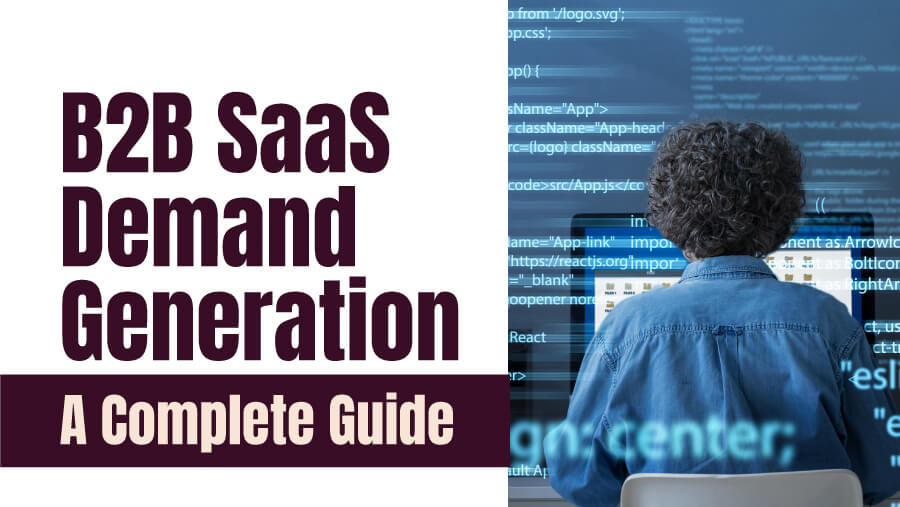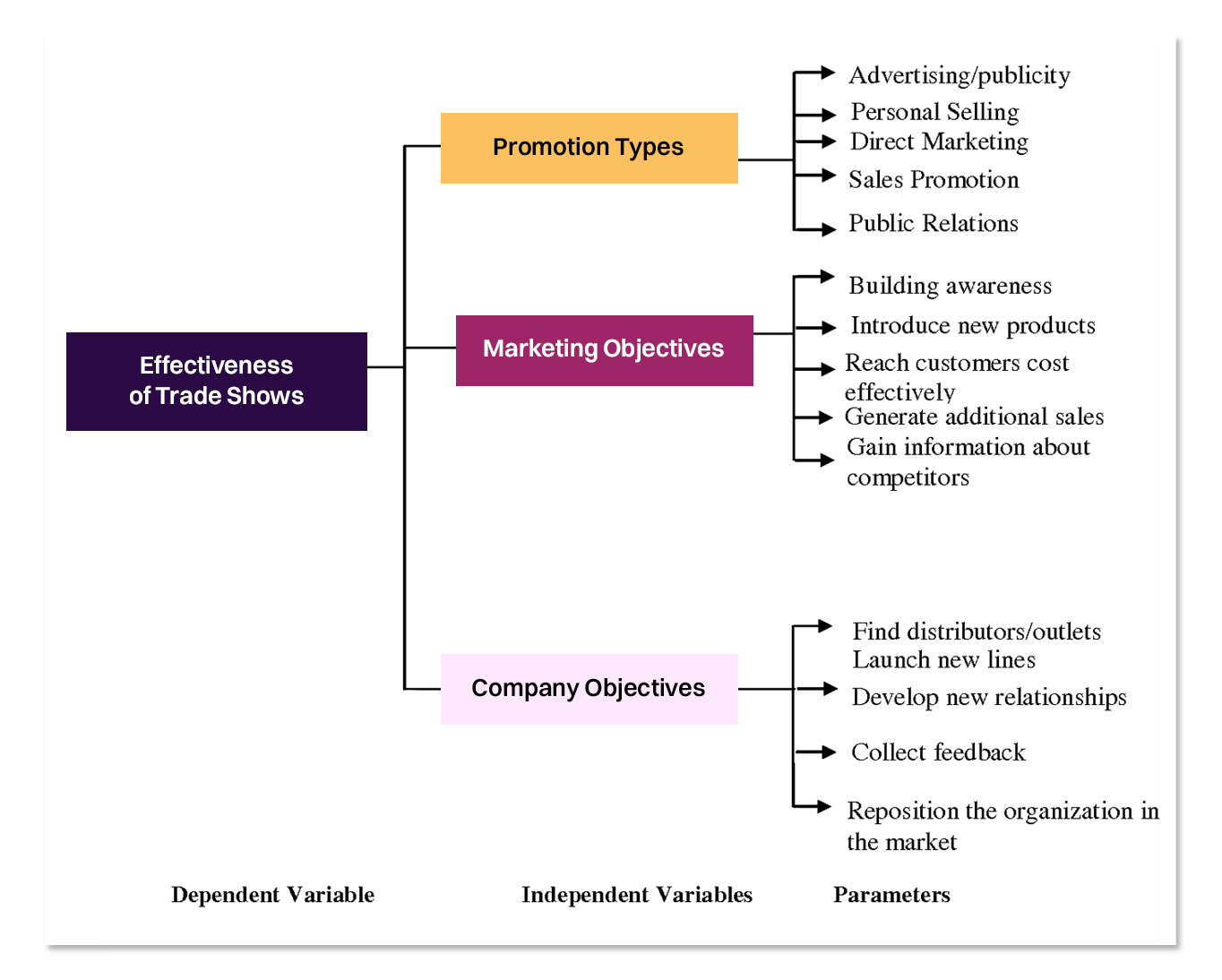
B2B SaaS Demand Generation - The Complete Guide [2024]
Today creating a great SaaS product is no longer enough. You have to create a proper buzz around it. This exposes your product to the right customers and piques their interest to learn more about your product's features. This phenomenon is called demand generation.
Now, you must be wondering what makes a successful SaaS demand generation. It involves knowing what channels and strategies to use, for example: you could work with a B2B SaaS SEO agency. To help you out, here's a demand generation guide for your SaaS business.
What Is B2B SaaS Demand Generation?
B2B SaaS demand gen is a strategic approach to generate demand for your offerings. It involves various marketing and sales tactics like content marketing, social media advertising, email campaigns, webinars, and more.
It requires you to educate prospective clients about your solution’s value in their business. It's a way to inspire buyers to invest in your services. The prime goals of SaaS demand generation are to establish your brand as a market leader, generate leads to convert them into paying customers, and boost the product's presence in the market among your competitors.
5 Objectives Of B2B SaaS Demand Generation

5 prime objectives of the demand generation in the B2B SaaS sector include:
- Creating awareness of the company and its products or services among the target audience.
- Attracting potential customers who have shown interest in the company's products or services.
- Engaging and educating the leads to move them closer to a purchasing decision.
- Boosting sales pipeline and revenue growth.
- Retaining and upscaling your existing customers.
What Channels To Use For SaaS Demand Gen?
Effective channel selection is crucial for creating a successful demand generation funnel for SaaS. However, each channel's ROI varies by industry. Here are the best channel options:
1. Linkedin Marketing
You must consider running LinkedIn Ads to generate demand for your SaaS offering. While creating the ads, make sure to include these elements:
A. Your B2B SaaS's core offering: Define how your product's core offering:- Meets your customers' needs
- Sets you apart from the competition. (Avoid emphasizing your SaaS product is faster, cheaper, or of higher quality than your competitors. It only provides a temporary edge in the market.) Instead, focus on long-term solutions.
Suppose you offer a SaaS model that improves an organization's overall management system. Then, you can highlight how a well-managed business sector benefits in terms of growth and revenue. Mention how your product solidifies the management framework in the long run.
Understanding these two points allows you to craft targeted ad messaging.
Your core offering must speak directly to your audience and highlights your unique value proposition. So, take the time to define it and create ads that truly resonate with your target audience.
B. Solutions to major issues: You need to offer a solution that's so compelling that it outweighs any potential challenges your audience may face in opting in.
Thus, they can't ignore the value you provide.
C. Your expertise: Position yourself as a thought leader in your industry through your ad messaging. It means showcasing your expertise and knowledge. It establishes trust and confidence in your SaaS product offerings. Provide valuable insights and solutions to become a go-to authority in your field.
2. Webinar Hosting
Here’s an example of an ideal structure of a webinar:
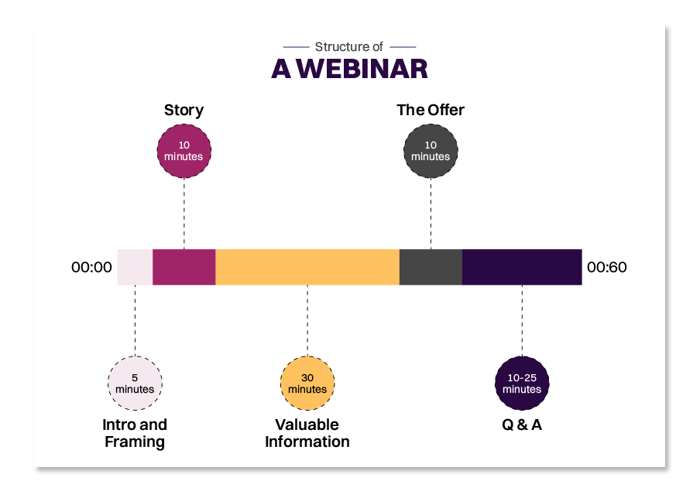
- Choose a date and time that suits your target audience.
- Select a platform that meets your technical requirements.
- Plan your content and prepare a presentation that is engaging and informative.
- Include interactive elements like polls, Q&A sessions, or breakout rooms.
- Identify your target audience and tailor your content to their needs and interests.
- Test your equipment and internet connection before the event and have a backup plan in case of technical difficulties.
- Assign roles and responsibilities to your team members and ensure everyone is clear on their tasks.
Next, you must promote your webinar and get registrations to ensure your webinar reaches its intended audience. Here's how to do it:
- Create a landing page that details the event, including the date, time, and registration link.
- Promote your webinar on your website, social media channels, and email lists.
- Contact industry influencers or partner with other organizations to expand your reach.
- Offer incentives for early registration, such as exclusive content or discounts.
- Make it easy for attendees to share the event with their networks.
- Follow up with registered attendees to provide reminders and additional information leading up to the event.
- After the event, follow up with attendees to gather feedback and insights to inform future webinars.
3. Events And Trade Shows
95% of marketers believe tradeshows are the best ways to build an in-person relationship with target prospects. Trade shows can be incredibly useful for businesses as marketing tools. They offer a combination of advertising, direct mail, direct selling, and internet networking benefits to reach the masses. It makes them a vital part of a company's marketing strategy.
Trade shows provide a unique setting where businesses can achieve a range of sales and marketing objectives. By bringing buyers and sellers together in one location, trade shows create a convenient and effective environment for doing business.
Focus on these four things while leveraging events and trade shows for demand generation for SaaS:- Target audience
- Budget
- Goals
- Messaging
Next, develop engaging booth displays and materials. Leverage social media and email marketing to promote your presence. Follow up with leads promptly to maximize ROI.
Begin by organizing and prioritizing leads based on their level of interest and potential value. Then, customize follow-up messages based on their specific needs and interests. Lastly, ensure to be prompt and persistent in your outreach.
Utilize a mix of email, phone calls, and social media to maintain engagement and nurture your leads after the shows. Consider offering incentives or exclusive content to encourage action and close deals.
Here’s an example of how you can measure the trade show’s effectiveness:
4. Content Syndication
With below-given few steps, you can leverage content syndication:
- Identify high-quality content that aligns with your target audience and marketing goals.
- Partner with reputable syndication networks and platforms. Ask them to distribute your content to their relevant audiences.
- Optimize your content for search engines and include clear calls to action to drive traffic and conversions.
- Track and analyze engagement metrics to optimize your strategy.
When evaluating content syndication opportunities, consider the following three questions:
A. Is the publication a credible information source for your target audience?
B. Can the opportunity provide a minimum guarantee of leads throughout the promotional period?
C. Will your content offer value to the third-party audience?
By answering these questions, you can ensure that the syndication will reach the right audience. It is one of the best ways for your content syndication campaigns. It expands your reach to ideal leads.
6 Strategies For B2B SaaS Demand Generation
1. Network With Decision-Makers And Influencers On Linkedin
4 out of 5 LinkedIn users have the power to influence business decisions. LinkedIn's official sales intelligence platform is tailor-made for business development teams. It offers powerful tools to help them connect with prospects and truly understand their needs. We advise you to use LinkedIn's Sales Navigator feature.
It lets you build targeted lead lists.
4 Types of Target Audience Data:
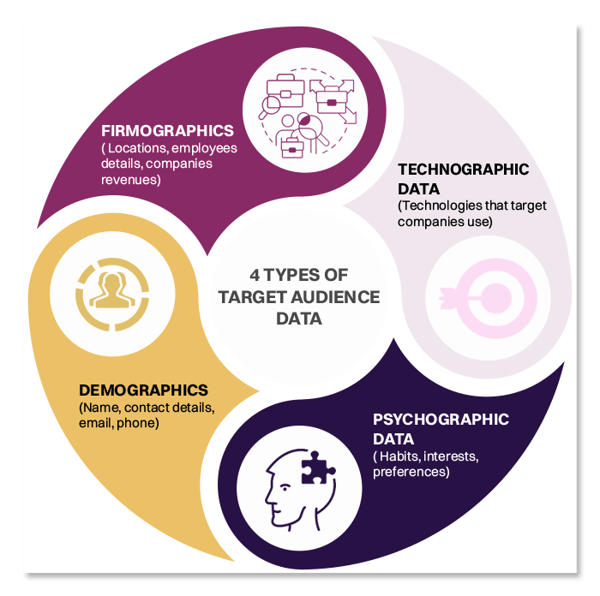
- Demographics (Name, contact details, email, phone)
- Firmographics ( Locations, employees details, companies revenues)
- Technographic data (Technologies that target companies use)
- Psychographic data ( Habits, interests, preferences)
To start:
- Create a professional and engaging profile highlighting your product's benefits.
- Use targeted search to identify decision-makers and influencers in your industry and reach out to them with personalized messages or connection requests.
- Share valuable content related to your product, including case studies, whitepapers, and thought leadership pieces, to demonstrate your expertise and build credibility.
- Engage in groups and discussions to showcase your knowledge and engage with potential customers.
- Consider investing in LinkedIn advertising to reach a wider audience and drive demand for your product.
2. Promote Limited-Time Coupons And Out Of Stock Items
You have to create scarcity in the market for your B2B product. It requires a strategic approach emphasizing urgency. Mention that the coupon or item is only available for a limited time. Use language that communicates the exclusivity of the offer.
It must encourage prospects to take advantage of it while they can. Highlight discounts, a free trial, or some other incentive. Make it clear how it will benefit the prospect's business. Use the following ways to promote your offerings:
- Send targeted emails to your email list highlighting the offer and encouraging recipients to act.
- Include a clear call to action that directs them to the appropriate landing page.
- Partner with influencers or industry experts to promote your offer. It can help increase visibility and generate demand among a targeted audience.
3. Give A High-Value Offer For Free
Looking to take your strategy up a notch? Consider crafting a tempting high-value offer that's free of charge for anyone interested. This sweet deal should showcase your very best work. It should provide your target accounts with helpful and relevant information regarding their business's growth.
Sharing top-notch content creates a stir around your brand and the featured product.
Additionally, this practice builds trust between your brand and your audience. In fact, some of your most enthusiastic prospects might even become ambassadors for your brand.
Rather than focusing solely on selling your SaaS product and its features, hone in on selling the overall experience of the solution you offer.
4. Release A Sneak-Peak Of The Most Relevant SaaS Product Information
Sometimes, less is more. Sharing limited yet essential SaaS solution's information can actually entice your prospects to seek out more. Provide just enough information to trigger their curiosity. It'll inspire them to do their own research and uncover more about what you offer.
It's all about sparking that initial interest and leaving them wanting for more. So don't be afraid to be a little mysterious. It's the key to capturing your audience's attention and driving demand for your products or services.
5. Connect With Outsourced Demand-Generation/Sales Partners
Being a SaaS business, your team mostly consists of tech geeks. Unfortunately, they aren't the professionals who can meet your sales requirements. Thus, you must outsource your sales partners specializing in SaaS demand generation.
These individuals have years of experience and a deeper understanding of your target prospects. They know how to get their attention and influence their decision-making process.
Ensure to research the outsourced partner thoroughly before hiring them. Revnew is one of the best B2B SaaS lead generation companies in the market. It works as a SaaS demand generation agency which is among many of its B2B services.
6. Cold Emailing
Cold emailing is a popular way to outreach your potential targets. Here's how your SaaS cold emailing works:
- Choose A Secondary Domain
Don't use your primary business domain for cold calling. Email providers can mark your emails as spam if you use them for frequently targeting prospects. It can negatively impact your business domain's reputation. A secondary domain will prevent this from happening. - Establish Your Secondary Email Reputation
Most emails from new domains fail to reach recipients' inboxes. It happens because senders do not follow the email warm-up process.
The process involves establishing the new email's reputation. Then, increasing its email-sending limit.
You have to start with a small number and then gradually increase it. We recommend you use an automated email warm-up process for better efficiency. - Follow Authentication Records
Doing so will ensure your emails are landing in the recipient's primary inbox. It includes the following:
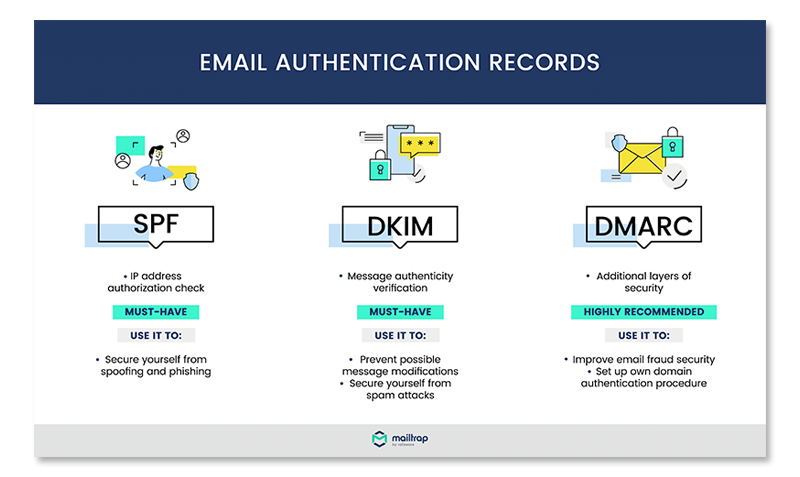
- DKIM (Domain Keys Identified Mail): It assures your email hasn't been tampered to its way to the sender.
- Sender Policy Framework (SPF): It allows the domain's owner to specify which users can email recipients on their behalf.
- DMARC (Domain-based Message Authentication, Reporting & Conformance): It prevents spammers from accessing your domains.
Thus, they can't send emails without your permission.
B2B Demand Generation Best Practices After Onboarding
1. Set Up A Lead-To-Revenue Model
Check out this basic design of the lead-to-revenue model:
Your team must learn in which scenarios your leads convert into paying prospects early on. They should also have a proven tactic to nurture them if they are not immediately responsive. It'll help you track and optimize the lead funnel by stage. Not having such a model in place makes it difficult to scale later.
Lead handoff is another significant part of the model. A successful lead handoff will require you to align your marketing and sales teams with these processes:- Criteria they'll use to score leads
- How will they hand them off
- Preferred follow-up strategies
- Metric to track leads' engagement and progress
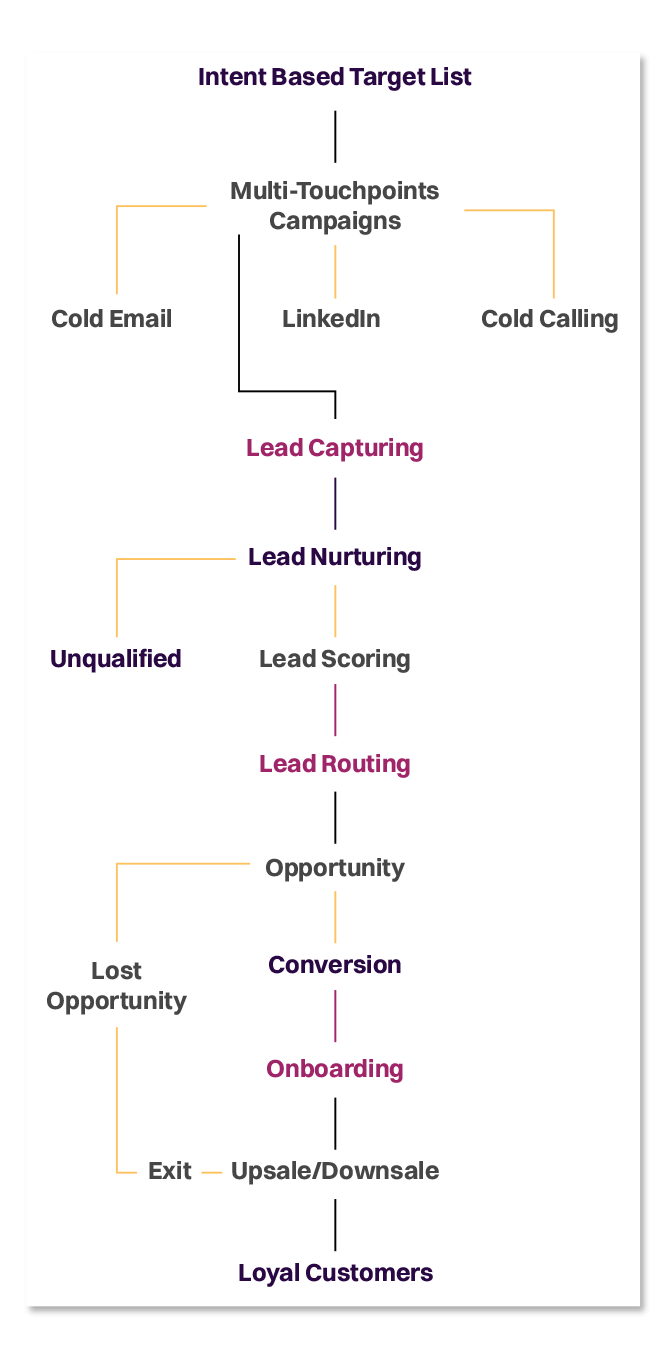
2. Email Drip Campaign
Demand generation doesn't stop once your prospects sign up for your website. In fact, how you nurture the leads matters the most. You can do this with a few drip campaign strategies. These include:
- Onboarding Email Sequence:
Welcome your leads after they submit their email details via a form. You can do it by sharing the content of their interests. It should offer value and entice leads to stay engaged. You can do this by:
- Including case studies and articles of the prospect's interest.
- Offer a time-bound welcome coupon.
- Retargeting Drip Campaign
This campaign is for prospects frequently engaging with your website after signing up. They may:
- Visit specific web pages many times.
- Download your white paper or ebook etc.
Your job is to curate your content based on their interest. It can accelerate demand for your SaaS model leading to a sale. You can offer them the following:
- A fillable workbook for the recent ebook or guide they downloaded.
- An email to request further conversation directly from a sales rep.
- Feedback request for their downloaded resource.
- Post-Demo Drip Campaign
- Video testimonials from previous clients.
- Tutorials on the feature(s) of the lead's interest.
- Offer an exclusive free trial.
What Are The Examples Of SaaS Demand Generation?
Let’s check out the successful B2B demand generation tactics of some SaaS businesses:
- Salesforce’s Free Trials Approach:
Salesforce is a customer relationship management (CRM) SaaS company. It offers free trials of its software to potential customers to let them experience the SaaS product firsthand.
Thus, they can see its value before making a purchase decision. Salesforce also provides free training resources and support to help users maximize their free trial experience.
- Yesware’s Cold Emailing:
Yesware is a sales productivity SaaS company that offers tools for email tracking, template creation, and analytics. The company uses cold emailing as one of its primary demand-generation tactics.
Yesware includes a personalized and targeted approach in cold emailing. Their tactics include:
- Carefully researching and segmenting their target audience.
- Crafting customized messages that speak to each prospect's specific pain points and needs. Using a variety of email templates and running A/B testing of their messaging and subject lines to optimize their response rates.
Here’s an example of Yesware’s cold emailing template:
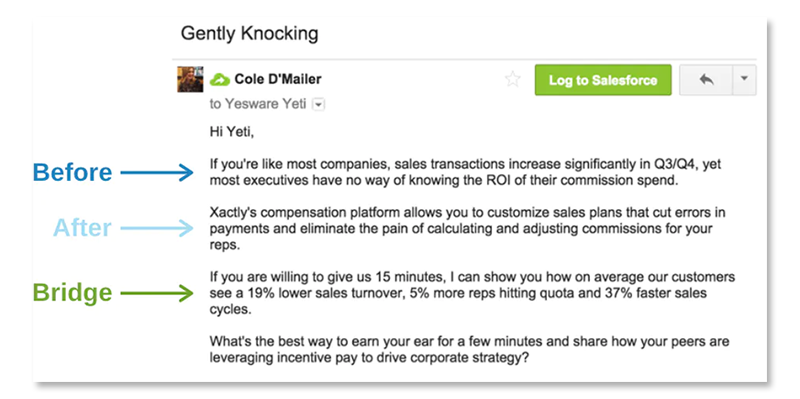
Through its cold emailing efforts, Yesware gets to grow its user base. Furthermore, it helps establish itself as a leader in the sales productivity space.
Conclusion
B2B SaaS demand generation is critical to any successful marketing strategy for SaaS companies. By effectively generating demand, you can attract and convert new customers. It will increase revenue, and ultimately you can achieve their growth objectives.
